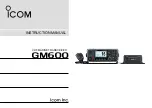
7
Circuit Description
Receiver Signal Path
“Main” Band 430 MHz Signal
The 430 MHz signal is passed through a high-pass filter
network and a low-pass filter network to the antenna
switch diodes
D1029, D1030
(both
RSL135
) and
D1001
(
HSC277TRF
), then passed through another low-pass fil-
ter network to the “Main” band RF amplifier
Q1001
(
3SK296ZQ
).
The amplified 430 MHz signal is passed through the band
switch
D1002
(
HSC277
) to the varactor-tuned band-pass
filter network consisting of
D1004
,
D1005
, and
D1006
(all
HVC350B
) and associated circuitry, then applied to the
first mixer
Q1003
(
3SK296ZQ
). Meanwhile, the UHF lo-
cal signal from the UHF-VCO/B
Q1116
(
2SC5006
) is de-
livered to first mixer
Q1003
, yielding the 45.05 MHz
“Main” band first IF.
“Main” Band 144 MHz Signal
The 144 MHz signal is passed through a low-pass filter
network and a high-pass filter network to the antenna
switch diodes
D1113, D1114
(both
UM9957F
),
D1115
,
D1116
(both
RLS135
) and
D1117
(both
RLS135
) then
passed through another low-pass filter network to the
“Main” band RF amplifier
Q1014
(
3SK296ZQ
).
The amplified 144 MHz signal is passed through a varac-
tor-tuned band-pass filter network consisting of
D1017
,
D1018
,
D1019
(all
HVC365
) and associated circuitry to
the first mixer
Q1016
(
3SK296ZQ
). Meanwhile, the VHF
local signal from the VHF-VCO/B
Q1120
(
2SC5374
) is
delivered to first mixer
Q1016
, yielding the 45.05 MHz
“Main” band first IF.
“Main” Band IF and AF Signals
The 45.05 MHz “Main” band first local signal is delivered
to the monolithic crystal filter
XF1001
which strips away
unwanted mixer products, then is passed through IF am-
plifier
Q1027
(
2SC4400
) to the IF IC
Q1044
(
TA31136FN
).
Meanwhile, a portion of the output of 11.15 MHz crystal
X1002
is multiplied fourfold by
Q1042
(
2SC4400
) to pro-
vide the 44.6 MHz second local signal, then delivered to
the IF IC
Q1044
. Within the IF IC
Q1044
, the 44.6 MHz
second local signal is mixed with the 45.05 MHz “Main”
band first local signal to produce the 450 kHz “Main” band
second IF.
The 450 kHz “Main” band second IF is passed through
the filter switch
D1039
/
D1041
(both
HSC277
) to the ce-
ramic filter
CF1001
(
CFWM450E
) which strips away all
but the desired signal, then it passes through the IF am-
plifier within Q1044 to the ceramic discriminator
CD1001
(
CDBM450C24
), which removes any amplitude variations
in the 450 kHz IF signal before detection of speech.
The demodulated “Main” band audio is passed through
the de-emphasis network, audio switch
D1047
(
DAN222
),
low-pass filter network (consisting of
Q1052
(
NJM2902V
)
and associated circuitry), and a high-pass filter network
(consisting of
Q1054
(
NJM2904V
) and associated circuit-
ry). The filtered audio signal is passed through the audio
volume control IC
Q1063
(
M51132FP
), which adjusts the
audio sensitivity to compensate for audio level variations,
then is delivered to the audio switch
Q1066
and
Q1067
(both
TC4W66FU
).
When the internal speaker is selected, the audio signal is
amplified by
Q1069
(
TDA7233D
) then applied to the in-
ternal loudspeaker. When the external speaker is select-
ed, the audio signal is amplified by
Q1068
(
LA4425A
),
then it passes through the
EXT SP
jack to the external loud-
speaker.
“Sub” Band 430 MHz Signal
The 430 MHz signal is passed through a high-pass filter
network and a low-pass filter network to the antenna
switch diodes
D1029, D1030
(both
RSL135
) and
D1001
(
HSC277TRF
), then passed through another low-pass fil-
ter network to the “Sub” band RF amplifier
Q1002
(
3SK296ZQ
).
The amplified 430 MHz signal is delivered through the
band switch
D1009
(
HSC277
) to the varactor-tuned band-
pass filter network consisting of
D1011
,
D1012
,
D1013
(all
HVC350B
) and associated circuitry, then applied to the
first mixer
Q1005
(
3SK296ZQ
). Meanwhile, the UHF lo-
cal signal from the UHF-VCO/A
Q1123
(
2SC5006
) is de-
livered to first mixer
Q1005
, yielding the 47.25 MHz “Sub”
band first IF.
“Sub” Band 144 MHz Signal
The 144 MHz signal is passed through a low-pass filter
network and a high-pass filter network to the antenna
switc diodes
D1113, D1114
(both
UM9957F
),
D1115
,
D1116
(both
RLS135
) and
D1117
(both
RLS135
), then
passed through another low-pass filter network to the
“Sub” band RF amplifier
Q1015
(
3SK296ZQ
).
The amplified 144 MHz signal is passed through the var-
actor-tuned band-pass filter network consisting of
D1020
,
D1021
,
D1022
(all
HVC365
) and associated circuitry to
the first mixer
Q1017
(
3SK296ZQ
). Meanwhile, the VHF
local signal from the VHF-VCO/A
Q1126
(
2SC5374
) is
delivered to first mixer
Q1017
, yielding the 47.25 MHz
“Sub” band first IF.
“Sub” Band IF and AF Signal
The 47.25 MHz “Sub” band first IF is delivered to the
monolithic crystal filter
XF1002
which strips away un-
wanted mixer products, then passed through the IF am-
plifier
Q1035
(
2SC4400
) to the IF IC
Q1047
(
TA31136FN
).
Содержание FT-8800E
Страница 4: ...4 Exploded View Miscellaneous Parts Note...
Страница 5: ...Block Diagram 5...
Страница 6: ...Block Diagram 6 Note...
Страница 16: ...16 Note...
Страница 18: ...MAIN Unit 18 Note...
Страница 44: ...44 MAIN Unit Note...
Страница 45: ...45 PANEL Unit Circuit Diagram...
Страница 50: ...50 PANEL Unit Note...
Страница 51: ...51 PANEL SUB Unit Circuit Diagram...








































